PROVO — George Frideric Handel’s Messiah has become a Christmas tradition for many over the last three centuries. The famous oratorio is presented every year in a myriad of ways, ranging from professional concerts in the worlds most famous opera houses to Messiah sing-along’s down at the local church. Every year the Covey Center for the Arts presents Messiah in it’s own way, through Joyful Noise, a play by Tim Slover.

Show closes December 22, 2012.
Joyful Noise tells the story about how Handel’s famous oratorio came to be. The play has become a Christmas tradition at the Covey Center, offering some variety amidst the countless productions of A Christmas Carol in the area. This year marks the fifth production of the play at the Covey Center. It’s popularity and success are most likely due to the over arching themes and message. Like Messiah, the play is a spiritual piece. Joyful Noise explores spirituality outside of the institution of religion and ultimately seeks to answer the question, “Where does God belong?” The spiritual nature of the piece works well during this special time of year, when many turn their hearts and minds both inward and upward.
The Covey’s Joyful Noise is successful in delivering its message. However, it struggles to do so because of issues in pacing. Scene changes often feel long and clumsy. It seems that all the furniture for a scene must to be swapped out for an entirely new set of furniture during every scene break. In this small space, moving several large pieces made for lengthy transitions that break up flow of the piece. Director Agnes Broberg utilizes the entirety of the stage space, but not in a way that enhances the piece. Instead, scenes run with a lack of focus and clear through-line, which in turn makes the story hard to follow. Actors are constantly moving about the stage, which makes the blocking feels somewhat contrived and unmotivated.
 The acting is, for the most part, two-dimensional and lacks a depth representative of these conflicted characters. Lon Keith’s Handel is a very frustrated and angry man, but unfortunately there isn’t much else. Handel’s gentler moments, primarily in the second half of the play, were difficult to justify, simply because he seemed flustered and upset for most the play. Susannah Cibber, portrayed by Katie Mecham, alternated between self-pity and anger, but again these shifts feel unjustified especially in her scenes with Handel near the end of the piece. Additionally, some of the actors lack a full command over the script and sometimes struggle to remember their lines.
The acting is, for the most part, two-dimensional and lacks a depth representative of these conflicted characters. Lon Keith’s Handel is a very frustrated and angry man, but unfortunately there isn’t much else. Handel’s gentler moments, primarily in the second half of the play, were difficult to justify, simply because he seemed flustered and upset for most the play. Susannah Cibber, portrayed by Katie Mecham, alternated between self-pity and anger, but again these shifts feel unjustified especially in her scenes with Handel near the end of the piece. Additionally, some of the actors lack a full command over the script and sometimes struggle to remember their lines.
The two strongest performances come from Shawn Lynn and Denise Gull, who function as a kind of comedic relief throughout the play. Lynn, in his performance of John Christopher Smith, is committed to his role and drives the play along with his comedic antics, especially in his scenes with Handel. Though Lynn’s performance was slightly over the top, it was a welcome contrast to the other characters in the piece. Gull, in her performance of Mary Pendarves, is another driving force in the play. Her character choices feel justified throughout the piece, as she contrasts a matronly love in her scenes with Susannah with a feisty determination when aiding Handel. Gull and Lynn both propel the play forward and added a unique vitality to the piece.
 The costumes, designed by Agnes Broberg, are appropriate for the period and helpful in creating the world of the play. However, it seems each of the costumes are slightly too big and baggy for each of the men in the show. Still, the style of costumes is effective in communicating both character and period. The wigs challenge the effectiveness of the costumes, however, because they do not sit quite properly on the actor’s heads, which is made apparent when some actors fidget with them during the play. Mel Broberg, as King George, made one of these adjustments mid-sentence during a scene. Belinda Purdum, as Kitty Clive, wears a wig, which under the stage light appears to be a vibrant plum color, which is distracting when contrasted to the more realistic wig colors present on stage.
The costumes, designed by Agnes Broberg, are appropriate for the period and helpful in creating the world of the play. However, it seems each of the costumes are slightly too big and baggy for each of the men in the show. Still, the style of costumes is effective in communicating both character and period. The wigs challenge the effectiveness of the costumes, however, because they do not sit quite properly on the actor’s heads, which is made apparent when some actors fidget with them during the play. Mel Broberg, as King George, made one of these adjustments mid-sentence during a scene. Belinda Purdum, as Kitty Clive, wears a wig, which under the stage light appears to be a vibrant plum color, which is distracting when contrasted to the more realistic wig colors present on stage.
Scenic elements, constructed by Samantha Layco and Michael James, are simple, but not all together unified. The king’s chair and footstool appear to be from the late 20th century, while the other furniture used throughout the piece is appropriate for the period. Music is pasted along the back wall for an appropriate and aesthetically pleasing backdrop for the action. The stage itself, vaguely shaped like the top of a piano or harpsichord, seemed to get in the way of the action more than enhance it. On more than one occasion, actors and technicians tripped on their way up and down the platforms.
Overall, the production’s pacing problems make the content difficult to engage with. The piece feels long and slightly under-rehearsed. However, even with its faults, the message of the Covey’s Joyful Noise is clear: God is in everything and God is for everyone. Though it is somewhat didactic, the play is uplifting and it’s spirit settles in nicely during the holidays. If you’re dying to find a show that will get you into the holiday spirit this season, and you’ve already seen A Christmas Carol, go see this production.





